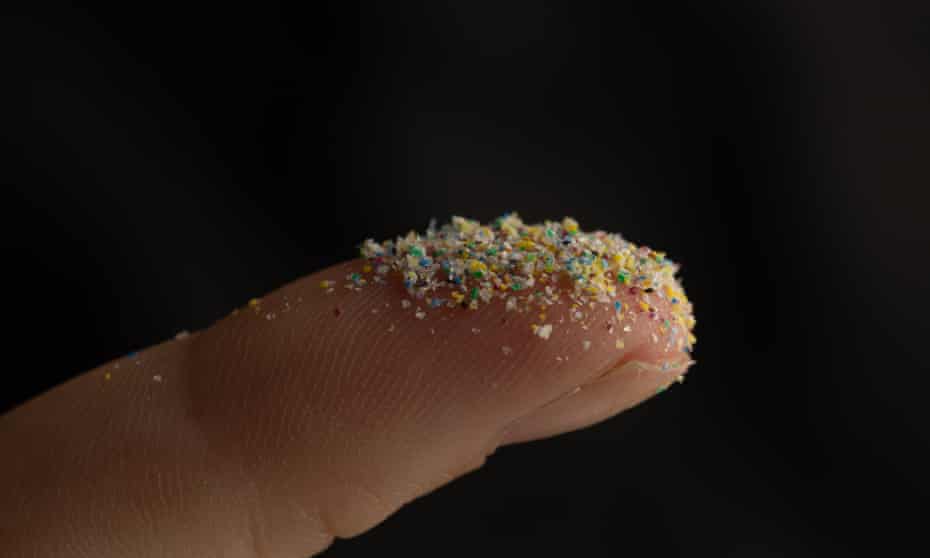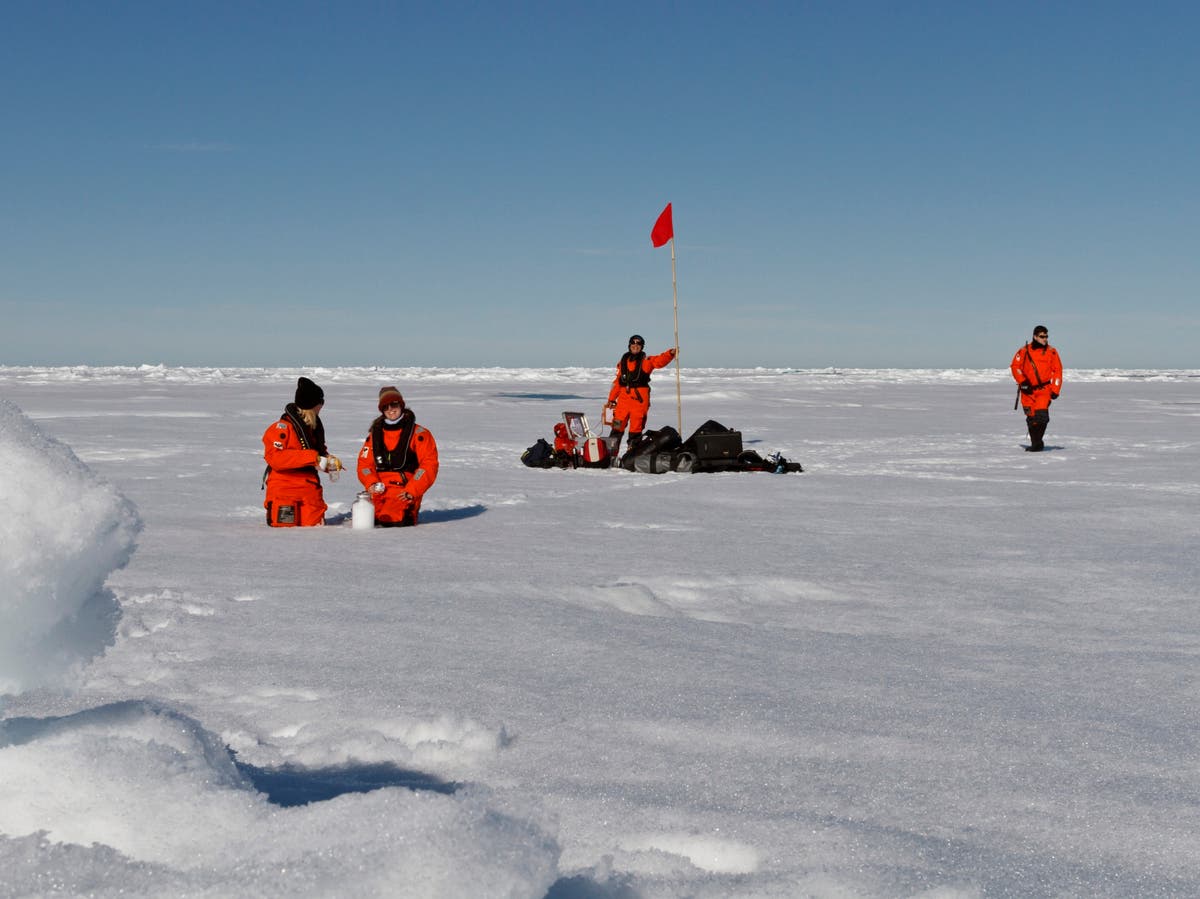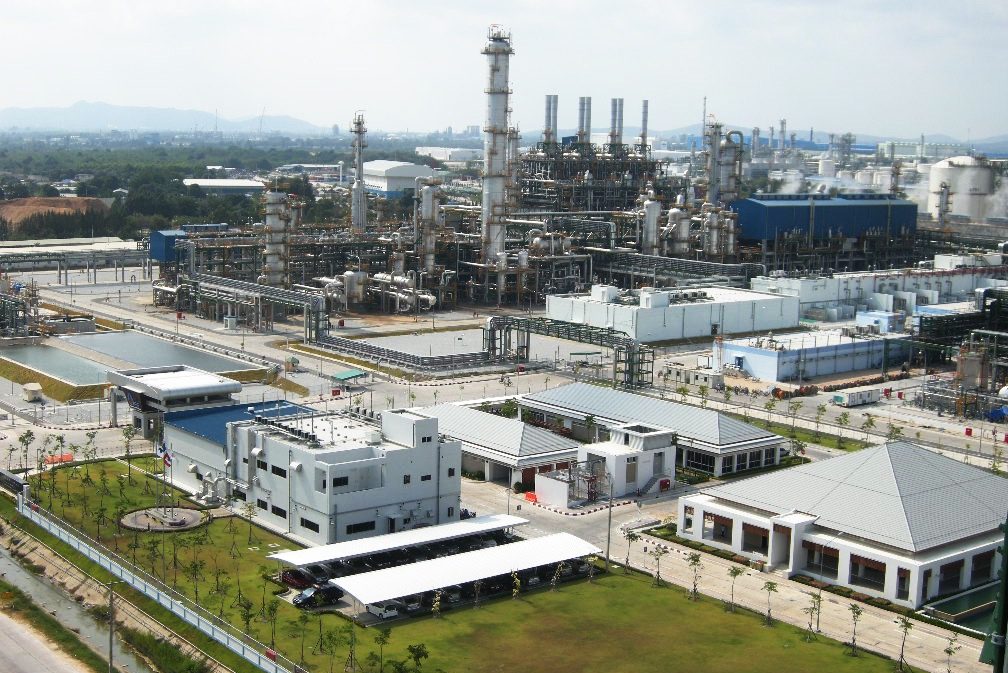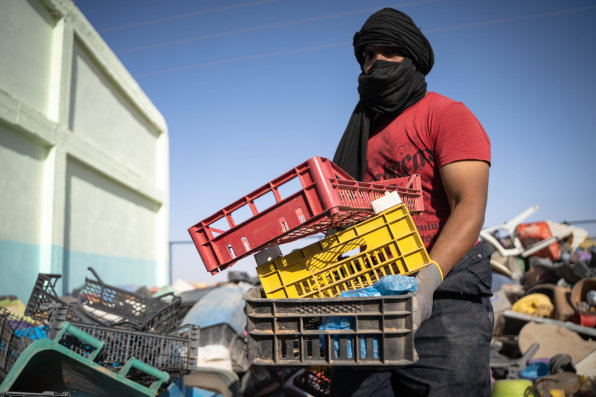Cleaning products are comprised of more than 90% water. So why are we buying new plastic hand soaps and cleaning sprays every time?
[Photo: Graham Pollack/courtesy Blueland]
By
Author Archives: David Evans
Microplastics found deep in lungs of living people for first time
Microplastics found deep in lungs of living people for first time Particles discovered in tissue of 11 out of 13 patients undergoing surgery, with polypropylene and PET most common Microplastic pollution has been discovered lodged deep in the lungs of living people for the first time. The particles were found in almost all the samples …
Continue reading “Microplastics found deep in lungs of living people for first time”
Strange 'flying' fish appear on North Wales beach
A small shoal of blue fish, seemingly flying through the air, has left walkers bemused on a North Wales beach. Perched on tall metal rods, they swivel and move with the wind. The 12 blue fish have appeared on the shoreline at Penmaenmawr, Conwy. Attached to a wooden sea defence groyn, they form a sculpture …
Continue reading “Strange 'flying' fish appear on North Wales beach”
The world’s ‘plastic flood’ has reached the Arctic
“All spheres” of the Arctic, from seafloors to rivers to remote areas of ice and snow, are now littered with “high concentrations” of waste plastics, scientists have said – and the situation is worsening.Large quantities of plastic waste and microplastic particles are now being transported to the Arctic by oceans, rivers, shipping and air, according to the research team from the Alfred Wegener Institute (AWI) in Bremerhaven, Germany.The huge quantity of plastic entering the world’s oceans and eventually ending up in the most remote places not only directly impacts ecosystems, but it could also exacerbate the climate crisis in the Arctic, the scientists said.This is because dark-coloured plastic particles could absorb more heat than snow and ice, and any suspended microplastics in the air could cause condensation – which then may cause additional rain, melting ice and snow.The research team said the Arctic Ocean has become a major plastic repository. Despite making up one per cent of the total volume of the world’s oceans, it receives more than 10 per cent of the global discharge from the world’s rivers, which carry plastic into the ocean.Today, virtually all marine organisms investigated, from plankton to sperm whales, come into contact with plastic debris and microplastics. And this applies to all areas of the world’s oceans, from tropical beaches to the deepest oceanic trenches.“The Arctic is still assumed to be a largely untouched wilderness,” says AWI expert Dr Melanie Bergmann.“In our review, which we jointly conducted with colleagues from Norway, Canada and the Netherlands, we show that this perception no longer reflects the reality.“Our northernmost ecosystems are already particularly hard hit by climate change. This is now exacerbated by plastic pollution. And our own research has shown that the pollution continues to worsen.”The researchers said their findings “paint a grim picture”. Although the Arctic is sparsely populated, in virtually all habitats – from beaches and the water column, to the seafloor – it shows a similar level of plastic pollution as densely populated regions around the globe.As well as rivers flowing into the Arctic Ocean, the pollution also stems from ocean currents from the Atlantic and the North Sea, and from the North Pacific over the Bering Strait. Tiny microplastic particles are also carried northward by wind.The plastics are then caught and swirled around the top of the globe. When seawater off the coast of Siberia freezes in the autumn, suspended microplastics become trapped in the ice. The Transpolar Drift current then transports the ice floes to Fram Strait between Greenland and Svalbard, where it melts in the summer, releasing its plastic cargo.The scientists said some of the biggest local sources of pollution are municipal waste and wastewater from Arctic communities and plastic debris from ships, especially fishing vessels, whose nets and ropes pose a serious problem. Either intentionally dumped in the ocean or unintentionally lost, they account for a large share of the plastic debris in the European sector of the Arctic: on one beach on Svalbard, almost 100 per cent of the plastic mass washed ashore came from fisheries, according to an AWI study.“Unfortunately, there are very few studies on the effects of the plastic on marine organisms in the Arctic,” said Dr Bergmann.“But there is evidence that the consequences there are similar to those in better-studied regions: in the Arctic, too, many animals – polar bears, seals, reindeer and seabirds – become entangled in plastic and die.“In the Arctic, too, unintentionally ingested microplastics likely lead to reduced growth and reproduction, to physiological stress and inflammations in the tissues of marine animals, and even runs in the blood of humans.”Speaking about the potential feedback loop which plastic debris could cause, and thereby exacerbate the climate crisis, the team said research remains “particularly thin”.“Here, there is an urgent need for further research,” said Dr Bergmann.“Initial studies indicate that trapped microplastics change the characteristics of sea ice and snow.”As well as absorbing heat and altering precipitation, the researchers said throughout their lifecycle, plastics are currently responsible for 4.5 per cent of global greenhouse-gas emissions.“Our review shows that the levels of plastic pollution in the Arctic match those of other regions around the world. This concurs with model simulations that predict an additional accumulation zone in the Arctic,” said Dr Bergmann.“But the consequences might be even more serious. As climate change progresses, the Arctic is warming three times faster than the rest of the world. Consequently, the plastic flood is hitting ecosystems that are already seriously strained.“The resolution for a global plastic treaty, passed at the UN Environment Assembly this February, is an important first step. In the course of the negotiations over the next two years, effective, legally binding measures must be adopted, including reduction targets in plastic production.”The team also called on European countries to slash their levels of plastic waste, and called for stronger controls on fishing gear entering oceans.The research is published in the journal Nature Reviews Earth & Environment.
The world’s ‘plastic flood’ has reached the Arctic
“All spheres” of the Arctic, from seafloors to rivers to remote areas of ice and snow, are now littered with “high concentrations” of waste plastics, scientists have said – and the situation is worsening.Large quantities of plastic waste and microplastic particles are now being transported to the Arctic by oceans, rivers, shipping and air, according to the research team from the Alfred Wegener Institute (AWI) in Bremerhaven, Germany.The huge quantity of plastic entering the world’s oceans and eventually ending up in the most remote places not only directly impacts ecosystems, but it could also exacerbate the climate crisis in the Arctic, the scientists said.This is because dark-coloured plastic particles could absorb more heat than snow and ice, and any suspended microplastics in the air could cause condensation – which then may cause additional rain, melting ice and snow.The research team said the Arctic Ocean has become a major plastic repository. Despite making up one per cent of the total volume of the world’s oceans, it receives more than 10 per cent of the global discharge from the world’s rivers, which carry plastic into the ocean.Today, virtually all marine organisms investigated, from plankton to sperm whales, come into contact with plastic debris and microplastics. And this applies to all areas of the world’s oceans, from tropical beaches to the deepest oceanic trenches.“The Arctic is still assumed to be a largely untouched wilderness,” says AWI expert Dr Melanie Bergmann.“In our review, which we jointly conducted with colleagues from Norway, Canada and the Netherlands, we show that this perception no longer reflects the reality.“Our northernmost ecosystems are already particularly hard hit by climate change. This is now exacerbated by plastic pollution. And our own research has shown that the pollution continues to worsen.”The researchers said their findings “paint a grim picture”. Although the Arctic is sparsely populated, in virtually all habitats – from beaches and the water column, to the seafloor – it shows a similar level of plastic pollution as densely populated regions around the globe.As well as rivers flowing into the Arctic Ocean, the pollution also stems from ocean currents from the Atlantic and the North Sea, and from the North Pacific over the Bering Strait. Tiny microplastic particles are also carried northward by wind.The plastics are then caught and swirled around the top of the globe. When seawater off the coast of Siberia freezes in the autumn, suspended microplastics become trapped in the ice. The Transpolar Drift current then transports the ice floes to Fram Strait between Greenland and Svalbard, where it melts in the summer, releasing its plastic cargo.The scientists said some of the biggest local sources of pollution are municipal waste and wastewater from Arctic communities and plastic debris from ships, especially fishing vessels, whose nets and ropes pose a serious problem. Either intentionally dumped in the ocean or unintentionally lost, they account for a large share of the plastic debris in the European sector of the Arctic: on one beach on Svalbard, almost 100 per cent of the plastic mass washed ashore came from fisheries, according to an AWI study.“Unfortunately, there are very few studies on the effects of the plastic on marine organisms in the Arctic,” said Dr Bergmann.“But there is evidence that the consequences there are similar to those in better-studied regions: in the Arctic, too, many animals – polar bears, seals, reindeer and seabirds – become entangled in plastic and die.“In the Arctic, too, unintentionally ingested microplastics likely lead to reduced growth and reproduction, to physiological stress and inflammations in the tissues of marine animals, and even runs in the blood of humans.”Speaking about the potential feedback loop which plastic debris could cause, and thereby exacerbate the climate crisis, the team said research remains “particularly thin”.“Here, there is an urgent need for further research,” said Dr Bergmann.“Initial studies indicate that trapped microplastics change the characteristics of sea ice and snow.”As well as absorbing heat and altering precipitation, the researchers said throughout their lifecycle, plastics are currently responsible for 4.5 per cent of global greenhouse-gas emissions.“Our review shows that the levels of plastic pollution in the Arctic match those of other regions around the world. This concurs with model simulations that predict an additional accumulation zone in the Arctic,” said Dr Bergmann.“But the consequences might be even more serious. As climate change progresses, the Arctic is warming three times faster than the rest of the world. Consequently, the plastic flood is hitting ecosystems that are already seriously strained.“The resolution for a global plastic treaty, passed at the UN Environment Assembly this February, is an important first step. In the course of the negotiations over the next two years, effective, legally binding measures must be adopted, including reduction targets in plastic production.”The team also called on European countries to slash their levels of plastic waste, and called for stronger controls on fishing gear entering oceans.The research is published in the journal Nature Reviews Earth & Environment.
The Arctic is filling up with plastic pollution
“Plastic pollution is very present in all spheres of the Arctic—no nice, white wilderness anymore.”
[Photos: Citizen of the Planet/Education Images/Universal Images Group/Getty Images, Nathan Yough/Unsplash]
By
The Arctic is filling up with plastic pollution
“Plastic pollution is very present in all spheres of the Arctic—no nice, white wilderness anymore.”
[Photos: Citizen of the Planet/Education Images/Universal Images Group/Getty Images, Nathan Yough/Unsplash]
By
Ohio regulators renew wastewater permit for proposed ethane cracker in Ohio
While Shell is scheduled to open an ethane cracker this year in Beaver County, north of Pittsburgh, a possible second cracker in the region faces an uncertain future.
These industrial plants use ethane from unconventional gas drilling in the region to create plastics.
The Ohio Environmental Protection Agency just renewed the wastewater discharge permit for PTTGC America, of Thailand, for its proposed facility in Belmont County, Ohio, about 70 miles southwest of Pittsburgh. It would produce 1.5 million tons of plastics per year.
Citizen comments on the permit mention that the River provides drinking water for roughly 5 million people and that there are concerns about the types of chemicals allowed to be discharged by the plant.
Ohio EPA said its standards are protective of drinking water and human health and that there is a water quality monitoring program on the Ohio River.
PTTGC is also in the process of drafting an application for an air permit from Ohio EPA to modify one that expired on February 24.
Still, it is uncertain if the company will build the plant.
“The real movement will come once the company identifies a partner, which hasn’t happened yet. That’s been the focus since the pandemic,” said spokesperson Dan Williamson.
This refugee camp in the Sahara is recycling trash into new products
One machine shreds the plastic into tiny pieces while other machines wash and dry them. Then they’re melted or pressed down to make furniture.
[Photo: courtesy Precious Plastic]
By
There’s good reason to worry about the health risks of plastics
An emerging domain of research shows that plastic consumption and pollution harms human health — particularly for the world’s lower-income communities.This builds on a growing field of research revealing the dangers of plastic on the environment — especially marine ecosystems. Of the over 8 billion tons of plastic produced since the 1950s, less than 10 percent has been recycled.“Plastic threatens human health at every stage of its production pipeline — from the extraction of the fossil carbon, oil and gas, that is plastic’s main constituent, to its manufacture, use and disposal,” said Philip Landrigan, director of the Global Observatory on Pollution and Health and lead author of the Lancet Commission on pollution and health.The connection between plastics and health was also highlighted in Africa by researchers from Stanford and the Technical University of Mombasa. After decades of hunting for mosquito-borne viruses in coastal Kenya, they received one of their greatest tips from a group of elementary schoolchildren.The scientists had been trying to uncover the breeding grounds of mosquitoes causing a number of illnesses that regularly sicken over half of Kenya’s coastal population — including dengue, chikungunya and others that can cause severe fevers, headaches, rashes, joint pain, life-threatening bleeding and death.With these diseases on the rise, researchers were teaching schoolchildren about the life stages and habitats of insects that serve as vectors. On a homework assignment to find immature forms of mosquitoes in their communities, the children discovered something unexpected — disease-carrying mosquitoes breeding in nests of plastic trash around their homes.“We were astounded,” said Stanford pediatrician and researcher Desiree LaBeaud, who led the project. “The children’s discovery helped us realize that the majority of mosquitoes were breeding in plastic trash and other containers littering streets and people’s yards.”Environment and health“We realized that we needed to look far beyond just treating the sick,” said LaBeaud, who is senior author on an upcoming publication in PLOS Neglected Tropical Diseases on the topic. “To stop these diseases at their source, we needed to tackle the plastic problem.”Plastics are closely tied to climate change, which the National Academy of Medicine (NAM) has recognized as “one of the most pressing existential threats to human health,” in the words of NAM President Victor J. Dzau. Plastics use the same amount of oil as the entire aviation industry — and are expected to more than triple in their oil consumption in the next 30 years.Moreover, the pollution caused by petrochemical plants — which are most often in lower-income settings — threaten the health of communities. “Plastic manufacture is inequitably distributed, with virtually all plastic production facilities located either in low- and mid-income countries or in poor and minority communities within high-income countries,” Landrigan pointed out.Disposing of plastic waste also poses challenges. In places such as sub-Saharan Africa, as much as three quarters of all waste is burned, releasing toxic compounds and carcinogens into the air.The infectious-disease research in coastal Kenya is a critical new dimension. Plastic pollution is exacerbating an already dire public health challenge — over 50 percent of people in coastal Kenya are regularly exposed to dengue and chikungunya, and at least 10 percent of febrile illness in the region is probably because of undiagnosed mosquito-borne viral infections. This pattern seems to be widespread — similar findings have emerged in South America and Asia.The problem is not only the potentially deadly diseases themselves. With symptoms for some illnesses such as chikungunya lasting for up to months or years, getting sick could also mean missing school and days of work — and communities being kept in poverty, creating what some scholars call the “disease-poverty trap.”“The case of plastics vividly illustrates how the industrial practices of the high-income world are intimately tied to the health and development of lower-income communities around the globe,” LaBeaud said. “Maintaining a healthy planet requires thinking carefully about how we produce, consume, and waste — knowing that downstream health impacts, especially on marginalized communities, won’t always be immediately apparent.”Fighting a growing problemCombating the plastic pollution in Kenya and other African countries involves addressing both exported recycling from high-income countries and an influx of new plastic products, especially single-use materials.Kenya, along with 95 other countries, received more than 1 billion pounds of foreign plastic waste from U.S. exporters in 2019 alone. This roughly equates to a line of 18-wheeler semi-trucks full of plastic trash backed up for about 350 miles, stretching nearly the entire length of Florida. And it’s not just plastic trash imports — Nairobi also saw a quadrupling in plastic consumption over the same 25-year period that its population only tripled.In response, Kenya banned single-use plastic bags in 2017 and banned all single-use plastic in protected natural sites in 2020. This is part of a larger movement to reduce plastic waste in Africa. The African Union, for example, has set a goal that 50 percent of waste used in African cities be recycled by 2023.Communities across Africa have also started exploding with locally designed solutions — exploring opportunities to rethink waste management and recycling in ways that also support local economies.For example, LaBeaud and Kenyan partners launched a nonprofit organization, HERI-Kenya, to engage policymakers, communicate the plastic-disease connection, and build business opportunities that allow for more locals to make a living collecting and recycling trash. This, they hope, can build the foundation for what is known as a circular economy for plastics, where the reuse and recycling of materials create a sustainable system of zero waste.“When we remove plastic litter, we not only improve local environments — we improve human health, beautify our community, support local entrepreneurs and boost tourism,” said Francis Mutuku, a researcher at the Technical University of Mombasa and LaBeaud’s long-term collaborator. “Everyone stands to gain.”Yet, despite the will to act, activists and lawmakers in Africa have found that the solution is not as simple as recycling or banning plastics.With fossil fuels increasingly falling out of favor, actors such as the American Chemistry Council (ACC) and large oil companies are reportedly moving toward a new strategy, opting to turn oil into plastics and distribute them to external markets, including countries in Africa. While the ACC has denied efforts to undermine bans on single-use plastics in places such as Kenya, many of the companies it represents are still expanding their production and distribution of plastics.In 2019, Chevron Phillips Chemical, a joint venture partially owned by Chevron, called petrochemical collaborations with Qatar Petroleum, now called QatarEnergy, “some of the safest and most successful assets in Chevron Phillips Chemical’s global portfolio” — including a new $8 billion project to develop a Gulf Coast petrochemical plant.“From delivering fresh water and preventing food waste to supplying medical products used every day in hospitals worldwide, our materials help people live prosperous and healthy lives,” Chevron Phillips Chemical said in an emailed statement.“With growing recognition around the negative health and environmental consequences of plastics, we do need to ask — why produce more?” Stanford Center for Innovation in Global Health Director Michele Barry said. “Where are these new chemical plants being built, and which communities are the intended recipients of these products?”Beyond recyclingRecycling is one of the most talked-about solutions for the plastics crisis.“ACC supports scaling up advanced recycling,” said Stewart Harris, senior director of Global Plastics Policy at the ACC, in an email, referring to recycling technology that breaks down used plastics into their basic building blocks to create new, often reusable, products. “Since 2017, 70 advanced recycling projects representing over $7 billion in investments have been announced or are already operating.”A wide range of companies have begun to invest in improved waste collection and recycling — for example, Chevron Phillips Chemical’s investments in circular plastics and Coca-Cola’s PETCO campaign in southern and eastern Africa.“We encourage responsible disposal of PET packaging and recycling of the same to create a circular economy, which has an economic impact on those involved throughout the recycling value-chain,” said Scott Leith, a spokesperson for Coca-Cola, who acknowledged that the challenge of plastic waste requires multiple approaches.While some local community organizations, such as Clean Up Kenya, have criticized Coca-Cola’s approach, advocates have noted that initiatives such as this one could allow simultaneous improvements in waste infrastructure, financial incentives for collectors and worker safety.“Partnerships between governments and the private sector are critical to achieving universal access to waste collection, which forms the foundation of a circular economy,” said Harris, in an emailed statement. Other groups such as the Alliance to End Plastic Waste are also trying to engage a variety of companies and organizations to accelerate community-engaged solutions.Yet researchers and policymakers have pointed out that recycling is no silver bullet, because of limitations in recycling capability and the environmental costs of producing plastics in the first place.Kenyan activists, including Clean Up Kenya, are calling for more comprehensive upstream solutions — including banning single-use plastic bottles overall.A 2020 report by SYSTEMIQ frames plastic collection and recycling as just one dimension of a strategy to reduce 80 percent of plastic pollution by 2040. Other critical channels of action noted in the report include reducing plastic consumption, substituting materials, redesigning products, securely disposing of the near-quarter of plastic that cannot be recycled — and, particularly relevant to Kenya’s plastic challenges, reducing “waste exports into countries with low collection and high leakage rates by 90%.”“There is an urgent need to simultaneously rein in plastic production and use in countries at every level of income,” Landrigan said.“We can’t recycle our way out of our global plastic problem,” Barry said. “Without a fundamental reimagining of global industrial practices, we will continue to see dire impacts on the climate, the planet and our health.”Erika Veidis serves as the planetary health program manager for the Stanford Center for Innovation in Global Health, where she leads the Action Lab for Planetary Health, a program focused on moving Stanford environmental and health research to solutions.Jamie Hansen serves as communications manager for the Stanford Center for Innovation in Global Health, helping to amplify the work of the center and its fellows through storytelling and multimedia communications.







